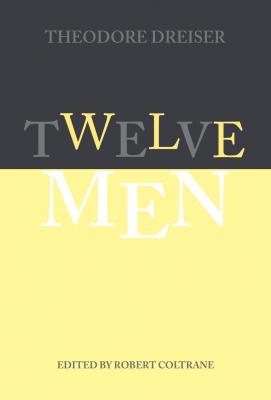Twelve Men. Theodore Dreiser
Читать онлайн.| Название | Twelve Men |
|---|---|
| Автор произведения | Theodore Dreiser |
| Жанр | Биографии и Мемуары |
| Серия | The University of Pennsylvania Dreiser Edition |
| Издательство | Биографии и Мемуары |
| Год выпуска | 0 |
| isbn | 9781512821543 |
TWELVE MEN
The University of Pennsylvania Dreiser Edition
Thomas P. Riggio, General Editor
James L. W. West III, Textual Editor
Lee Ann Draud, Textual Editor
A complete list of books in the series
is available from the publisher.
TWELVE MEN
THEODORE DREISER
Edited by
ROBERT COLTRANE
PENN
University of Pennsylvania Press
Philadelphia
Copyright © 1998 University of Pennsylvania Press
All rights reserved
Printed in the United States of America on acid-free paper
10 9 8 7 6 5 4 3 2 1
Published by
University of Pennsylvania Press
Philadelphia, Pennsylvania 19104-4011
Library of Congress Cataloging-in-Publication Data
Dreiser, Theodore, 1871-1945
Twelve men / Theodore Dreiser ; edited by Robert Coltrane.
p. cm. — (The University of Pennsylvania Dreiser edition)
Includes bibliographical references
1. Character sketches. 2. United States—Biography.
I. Coltrane, Robert. II. Title. III. Series.
PS3507/R55T9 1998
920'.073—dc21
97-48786
CIP
CONTENTS
Preface by Thomas P. Riggio
Publication History
Biographical Sketches
Illustrations
Historical Notes
Subsequent Textual History
Textual Notes
Rejected Editorial Changes
Copy-Text Readings That Differ from Manuscript and Periodical Versions
Table of Representative Revisions
Pedigree of Editions
ILLUSTRATIONS
Dreiser around 1900
Dreiser as a mature writer (1917–18)
Illustration by Louis Sonntag for “The Scotch Express”
Illustration by William Glackens for “A True Patriarch”
“Heart Bowed Down,” first page of holograph for sketch for “The Village Feudists”
Island cabin, Noank, Connecticut
Dust jacket for Boni and Liveright first edition of Twelve Men, 1919
PREFACE
Twelve Men (1919) has long been recognized as Theodore Dreiser’s finest work apart from his novels. H. L. Mencken, who had become increasingly unhappy with Dreiser’s writing after The Titan (1914), thought that it was a return to “the manner of Sister Carrie and Jennie Gerhardt… the manner of pure representation, of searching understanding, of unfailing gusto and contagious wonderment.” Mencken had good cause to look to the past in his review of the book. In Twelve Men Dreiser had collected and reshaped material written from the turn of the century to the years just before its publication. The book thus constitutes a rough index to the two most productive decades of his career. It stands as a marker of sorts between the work of those years and his most ambitious book, An American Tragedy, which he began writing shortly after Twelve Men appeared.
In 1919 no one expected the book to have much of an impact. Even the publisher, Horace Liveright, thought it an expensive indulgence that he hoped would encourage Dreiser to get back to his true business of writing novels. Liveright had no reason to think otherwise. Dreiser’s material was dated: it derived from the 1890s and the pre-World War I years. Moreover, this was, of all things, a quasi-memoir by a German-American author whose loyalties had been questioned publicly during the war. Sales of Twelve Men turned out to be good, however, especially for a work of nonfiction. Although not a best-seller, it developed a solid and broad readership; it went through ten printings between 1919 and 1931 and was issued in the popular Modern Library series. When the American Academy of Arts and Letters presented Dreiser with the Award of Merit Medal in 1944, it cited only three books by title: Sister Carrie, An American Tragedy, and Twelve Men.
These twelve biographical portraits belong to a distinct species of writing in Dreiser’s oeuvre, a form born of his reluctance to make sharp distinctions between the art of the chronicler and that of the novelist. These essays, which he called “narratives,” combine the character sketch and autobiography within the framework of the short story. Written in the clear, unobtrusive manner of the reporter, they show Dreiser’s command of dialogue and his novelist’s eye for the details of scene and setting. The structure of each narrative—the presentation of selected fragments of a life with the counterpoint of Dreiser’s presence and reaction to the personality—gives the collection a dual direction: outward to objective portraiture of character and place and inward to a portrait of Dreiser himself. The figure at the center of the book shows a number of different faces to his readers. In places he is the Rousseauean author confessing to his youthful inhibitions, in others the man of sensibilité lamenting the inconstancy of fate, and in still others the older writer observing his early years from the lofty heights of worldly experience. The stories are among the best examples of the imaginative possibilities of autobiographical literature as Dreiser practiced it. In them he gives artistic shape to his experience and lifts his material from the realm of journalism to a type of writing that is meditative and affective but difficult to define precisely.
Although Dreiser’s presence informs each sketch, his subjects, the twelve men of the title, supply the substance that unites their various stories. Collectively they represent individuals whose lives challenge the conventional norms of their time. They range from Dreiser’s charitable
